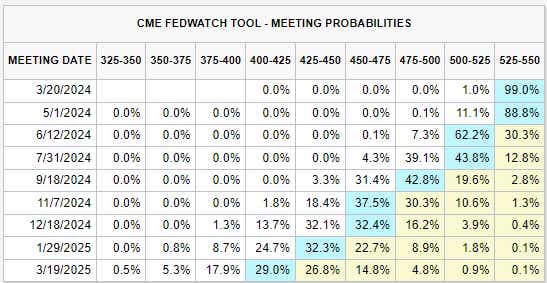Bonds May Be a Dead Trade After CPI

Bonds May Be a Dead Trade After CPI
Market update: the U.S. 10-year yield moves up to 4.159%
- U.S. Treasury notes and bonds are weaker following the surprisingly hotter February U.S. inflation report.
- Rate cut odds for 2024 are trending lower, with the odds of a 25-bps rate cut in March only at 1% while the odds of a June cut have dropped to 69.6%.
- Bond volatility remains missing despite the considerable swings over the past week.

The February U.S. inflation report introduced a new reality to the bond market on Tuesday.
Stubborn price pressures are diminishing the likelihood that the Federal Reserve can bring inflation back to +2% y/y in 2024. What should be a friendly base effect period in the inflation data is instead being squandered.
This new reality in the bond market is that traders might need to zero out any lingering rate-cut odds for March and May in the coming weeks. There’s still enough "meat on the bone" there for the zeroing out of those odds to be a short-term headwind for bonds, particularly at the short end of the curve.

But it’s not just March and May. Fed rate cut odds continue to be depleted across the board. The odds of a June cut remain reasonably priced at 69.6%, but some pushback there as well to more of a coin flip could likewise lead to an additional headwind for bonds in the short-term.
That’s not to say that this leads to the conclusion that it’s prudent to trade with a short-delta bias in bonds. It remains the case that any bets on meaningful directional weakness are bets that the Federal Reserve will not cut rates in the first half of 2024.
What it does means is bonds may be set for a period of choppy trading—arguably, they’ve been in a period of choppy trading. While ranges forming are appealing for directionless strategies like short strangles or iron condors, the fact of the matter is that volatility is nowhere to be found (/ZNM4–IV rank: 1.3; /ZBM4–implied volatility (IV) rank: 6.9). The bond trade is effectively dead now.
/ZN U.S. 10-year note price technical analysis: daily chart (October 2023 to March 2024)

The U.S. 10-year Treasury note (/ZNM4) may be carving out a double top against the Feb. 7 and March 8 swing highs near 112’05, or it simply may be resistance in a sideways range that’s been in place for more than a month.
The daily 21-day exponential moving average (one-month moving average) is serving as initial support, but a loss of this level would suggest that the range will prevail rather than the nascent series of higher lows and higher highs over the past two weeks.
Traders may find the 109’25/112’05 consolidation technically sound for deploying range trading strategies like short strangles or iron condors. However, there’s not much juice to be squeezed, on a risk/reward basis, given the diminished volatility environment (IV index: 6.6%; IV rank: 1.3). The trade may be viable, but there may also be better opportunities elsewhere (like in precious metals, which are rate sensitive but have much higher IV ranks).
/ZB US 30-year bond price technical analysis: daily chart (October 2023 to March 2024)

The inverse head and shoulders pattern off the lows called for a measured move higher by the U.S. Treasury 30-year bond (/ZBM4) into 122’03, which was achieved last week when /ZBM4 hit 122’13.
Since then, the uptrend off the February and March swing lows has started to buckle, pushing /ZBM4 back into the middle of the symmetrical triangle that’s been forming since early-December 2023. Much like /ZNM4, there is a discernible range, but is the trade worth it? With duly low volatility (IV index: 12%; IV rank: 6.9), /ZBM4 may be a dead market for the near future (at least until support or resistance are reached).
Christopher Vecchio, CFA, tastylive’s head of futures and forex, has been trading for nearly 20 years. He has consulted with multinational firms on FX hedging and lectured at Duke Law School on FX derivatives. Vecchio searches for high-convexity opportunities at the crossroads of macroeconomics and global politics. He hosts Futures Power Hour Monday-Friday and Let Me Explain on Tuesdays, and co-hosts Overtime, Monday-Thursday. @cvecchiofx
For live daily programming, market news and commentary, visit tastylive or the YouTube channels tastylive (for options traders), and tastyliveTrending for stocks, futures, forex & macro.
Trade with a better broker, open a tastytrade account today. tastylive, Inc. and tastytrade, Inc. are separate but affiliated companies.
Options involve risk and are not suitable for all investors. Please read Characteristics and Risks of Standardized Options before deciding to invest in options.
tastylive content is created, produced, and provided solely by tastylive, Inc. (“tastylive”) and is for informational and educational purposes only. It is not, nor is it intended to be, trading or investment advice or a recommendation that any security, futures contract, digital asset, other product, transaction, or investment strategy is suitable for any person. Trading securities, futures products, and digital assets involve risk and may result in a loss greater than the original amount invested. tastylive, through its content, financial programming or otherwise, does not provide investment or financial advice or make investment recommendations. Investment information provided may not be appropriate for all investors and is provided without respect to individual investor financial sophistication, financial situation, investing time horizon or risk tolerance. tastylive is not in the business of transacting securities trades, nor does it direct client commodity accounts or give commodity trading advice tailored to any particular client’s situation or investment objectives. Supporting documentation for any claims (including claims made on behalf of options programs), comparisons, statistics, or other technical data, if applicable, will be supplied upon request. tastylive is not a licensed financial adviser, registered investment adviser, or a registered broker-dealer. Options, futures, and futures options are not suitable for all investors. Prior to trading securities, options, futures, or futures options, please read the applicable risk disclosures, including, but not limited to, the Characteristics and Risks of Standardized Options Disclosure and the Futures and Exchange-Traded Options Risk Disclosure found on tastytrade.com/disclosures.
tastytrade, Inc. ("tastytrade”) is a registered broker-dealer and member of FINRA, NFA, and SIPC. tastytrade was previously known as tastyworks, Inc. (“tastyworks”). tastytrade offers self-directed brokerage accounts to its customers. tastytrade does not give financial or trading advice, nor does it make investment recommendations. You alone are responsible for making your investment and trading decisions and for evaluating the merits and risks associated with the use of tastytrade’s systems, services or products. tastytrade is a wholly-owned subsidiary of tastylive, Inc.
tastytrade has entered into a Marketing Agreement with tastylive (“Marketing Agent”) whereby tastytrade pays compensation to Marketing Agent to recommend tastytrade’s brokerage services. The existence of this Marketing Agreement should not be deemed as an endorsement or recommendation of Marketing Agent by tastytrade. tastytrade and Marketing Agent are separate entities with their own products and services. tastylive is the parent company of tastytrade.
tastyfx, LLC (“tastyfx”) is a Commodity Futures Trading Commission (“CFTC”) registered Retail Foreign Exchange Dealer (RFED) and Introducing Broker (IB) and Forex Dealer Member (FDM) of the National Futures Association (“NFA”) (NFA ID 0509630). Leveraged trading in foreign currency or off-exchange products on margin carries significant risk and may not be suitable for all investors. We advise you to carefully consider whether trading is appropriate for you based on your personal circumstances as you may lose more than you invest.
tastycrypto is provided solely by tasty Software Solutions, LLC. tasty Software Solutions, LLC is a separate but affiliate company of tastylive, Inc. Neither tastylive nor any of its affiliates are responsible for the products or services provided by tasty Software Solutions, LLC. Cryptocurrency trading is not suitable for all investors due to the number of risks involved. The value of any cryptocurrency, including digital assets pegged to fiat currency, commodities, or any other asset, may go to zero.
© copyright 2013 - 2025 tastylive, Inc. All Rights Reserved. Applicable portions of the Terms of Use on tastylive.com apply. Reproduction, adaptation, distribution, public display, exhibition for profit, or storage in any electronic storage media in whole or in part is prohibited under penalty of law, provided that you may download tastylive’s podcasts as necessary to view for personal use. tastylive was previously known as tastytrade, Inc. tastylive is a trademark/servicemark owned by tastylive, Inc.